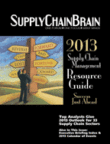
Visit Our Sponsors |
|
|
|
|
|
|
|
|
|
|
|
|
|
|
|
|
|
|
|
|
|
|
|
|
|
|
|
|
|
|
|
|
|
|
|
|
|
|
|
|

The article "How the Pharmaceutical Industry Has Dramatically Reduced Thefts" describes how the pharmaceutical industry has achieved over 50X reduction in pharmaceutical theft in the U.S. over the last four years. It also describes how the largest theft during that period ($76m of drugs stolen from an Eli Lily warehouse in March 2010) was thwarted by information sharing within the industry. And what was the information that was shared? The lot and batch numbers of the stolen drugs. As a result of the high publicity of the case, that stash of drugs became "hot property" and none of the distributors and wholesalers wanted to touch it (including those who, in the past, may have been willing to look the other way). As a result, the thieves were unable to sell those drugs and they were fully recovered when the ring was broken two years later, in May 2012.
This incident highlights the role that traceability (the recording of lot and batch numbers) can play in combating theft. The primary objective of traceability is typically not theft control, but rather quality control and enabling recall capabilities. Pharmaceutical companies"”and some companies in other industries with quality and recall concerns, such as food, aerospace, high-tech, and chemicals"”will record the lot and batch numbers of all the input ingredients or components and record which output lots and batches those ingredients went into.
Of course it takes more than just recording lot numbers to thwart theft. In the case of the pharmaceutical industry, they have put considerable effort to create communities and networks of manufacturers, transportation carriers, law enforcement (including federal agencies), distributors and others to share information about thefts"”such as sharing best practices as well as real-time information whenever a theft occurs. A good example is the Pharmaceutical Cargo Security Coalition. Over time, these networks have gotten better and better at sharing and acting on information. And one of the key pieces of information they share is the lot and batch numbers that identify the stolen goods.
Serialization goes beyond traditional lot and batch level traceability to identify individual items as they are manufactured and distributed through retail or other end points to the end consumer. As such, serialization provides item-level traceability and potentially the ability to authenticate whether any individual item is authentic (vs. counterfeit) and/or whether that item has been distributed through legitimate channels (vs. gray markets/diversion or outright theft). To date, the use of serialization as an anti-theft tool is not widespread, but the potential is there.
The Outlook
Serialization, which has not been widely adopted up to now, may see an uptick in adoption in 2013 by some pharmaceutical manufacturers as they prepare to implement the California e-pedigree laws. However, anti-theft concerns will likely not be a major driver of either traceability or serialization solutions adoption in 2013.
Keywords: supply chain risk management, supply chain management, pharmaceutical supply chain, healthcare supply chain, e-pedigree, serialization in supply chain
RELATED CONTENT
RELATED VIDEOS
Timely, incisive articles delivered directly to your inbox.



.jpg?height=100&t=1715228265&width=150)


